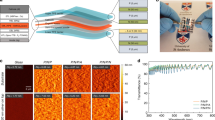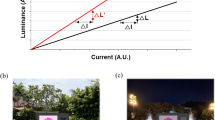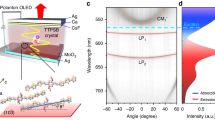Abstract
Organic light-emitting diodes (OLEDs) are among the most successful organic electronic devices so far. They currently dominate the mobile display market and are expanding into a broad range of lighting, automotive and wearable device applications. Here we introduce a new class of organic light-emitting device that exhibits bistability owing to positive photonic feedback between an organic photodiode and a tandem OLED integrated in the same layer stack. These unusual devices display giant hysteresis in both their current and light emission, and respond sensitively to low-level external illumination, enabling optoelectronic upconversion with 100-fold photon-to-photon gain. Given their compatibility with existing OLED materials and manufacturing lines, these devices could find near-term use in new types of display and upconversion imaging applications, as well as offer a new platform for neuromorphic optoelectronics and image recognition.
This is a preview of subscription content, access via your institution
Access options
Access Nature and 54 other Nature Portfolio journals
Get Nature+, our best-value online-access subscription
$32.99 / 30 days
cancel any time
Subscribe to this journal
Receive 12 print issues and online access
$259.00 per year
only $21.58 per issue
Buy this article
- Purchase on SpringerLink
- Instant access to full article PDF
Prices may be subject to local taxes which are calculated during checkout




Similar content being viewed by others
Data availability
The data that support the findings of this study are available from the corresponding authors on reasonable request.
References
Forrest, S. R. Organic Electronics (Oxford Univ. Press, 2020); https://doi.org/10.1093/oso/9780198529729.001.0001
Hany, R., Cremona, M. & Strassel, K. Recent advances with optical upconverters made from all-organic and hybrid materials. Sci. Technol. Adv. Mater. 20, 497–510 (2019).
Lv, W. et al. Organic near-infrared upconversion devices: design principles and operation mechanisms. Org. Electron. 31, 258–265 (2016).
Song, Q. et al. Organic upconversion display with an over 100% photon-to-photon upconversion efficiency and a simple pixelless device structure. J. Phys. Chem. Lett. 9, 6818–6824 (2018).
Kim, D. Y. et al. PbSe nanocrystal-based infrared-to-visible up-conversion device. Nano Lett. 11, 2109–2113 (2011).
Yu, H. et al. High-gain infrared-to-visible upconversion light-emitting phototransistors. Nat. Photon. 10, 129–134 (2016).
He, S.-J., Wang, D.-K., Yang, Z.-X., Man, J.-X. & Lu, Z.-H. Integrated tandem device with photoactive layer for near-infrared to visible upconversion imaging. Appl. Phys. Lett. 112, 243301 (2018).
Noda, S., Yamada, E., Takayama, T. & Sasaki, A. Light-controlled optical bistable device by bistable laser diode and heterojunction phototransistor. Electron. Lett. 26, 1069 (1990).
Noda, S., Takayama, T., Shibata, K. & Sasaki, A. Optical functional device by vertical and direct integration of heterojunction phototransistor and laser diode. J. Lightwave Technol. 10, 2023–2031 (1992).
Noda, S. & Sasaki, A. Vertical and direct integration of heterojunction phototransistors and laser diodes. Fiber Integr. Opt. 12, 319–345 (1993).
Xue, J. & Forrest, S. R. Organic optical bistable switch. Appl. Phys. Lett. 82, 136–138 (2003).
Shih, C.-J. et al. Transparent organic upconversion devices displaying high-resolution, single-pixel, low-power infrared images perceived by human vision. Sci. Adv. 9, eadd7526 (2023).
Du, X. et al. Efficient organic upconversion devices for low energy consumption and high‐quality noninvasive imaging. Adv. Mater. 33, 2102812 (2021).
Li, N., Eedugurala, N., Leem, D., Azoulay, J. D. & Ng, T. N. Organic upconversion imager with dual electronic and optical readouts for shortwave infrared light detection. Adv. Funct. Mater. 31, 2100565 (2021).
Yuan, C.-H. et al. Cathodic-controlled and near-infrared organic upconverter for local blood vessels mapping. Sci Rep. 6, 32324 (2016).
Psaltis, D. Optical realizations of neural network models. In 1986 Intl Optical Computing Conf. (eds. Friesem, A. A., Marom, E. & Shamir, J.) 700, 278 (1987); https://doi.org/10.1117/12.936987
El Srouji, L. et al. Photonic and optoelectronic neuromorphic computing. APL Photon. 7, 051101 (2022).
Wang, Y. et al. Optoelectronic synaptic devices for neuromorphic computing. Adv. Intell. Syst. 3, 2000099 (2021).
Gao, X.-C., Zou, D.-C., Fujita, K. & Tsutsui, T. Switchable organic electroluminescence. Appl. Phys. Lett. 81, 4508–4510 (2002).
Tseng, R. J., Ouyang, J., Chu, C.-W., Huang, J. & Yang, Y. Nanoparticle-induced negative differential resistance and memory effect in polymer bistable light-emitting device. Appl. Phys. Lett. 88, 123506 (2006).
Kim, S. H., Yook, K. S., Lee, J. Y. & Jang, J. Organic light emitting bistable memory device with high on/off ratio and low driving voltage. Appl. Phys. Lett. 93, 053306 (2008).
Fung, M., Li, Y. & Liao, L. Tandem organic light‐emitting diodes. Adv. Mater. 28, 10381–10408 (2016).
Zhao, D., Qin, Z., Huang, J. & Yu, J. Progress on material, structure and function for tandem organic light-emitting diodes. Org. Electron. 51, 220–242 (2017).
Septian, M. R. A. et al. Vacuum-deposited organic photodetectors utilizing non-fullerene acceptors for enhanced detectivity in the green visible light spectrum. J. Mater. Chem. C Mater 11, 16972–16981 (2023).
Lee, C. et al. Vacuum‐Processed small molecule organic photodetectors with low dark current density and strong response to near‐infrared wavelength. Adv. Opt. Mater. 8, 2000519 (2020).
Mihailetchi, V. D., Koster, L. J. A., Hummelen, J. C. & Blom, P. W. M. Photocurrent generation in polymer-fullerene bulk heterojunctions. Phys. Rev. Lett. 93, 216601 (2004).
Fukuhara, T., Tamai, Y. & Ohkita, H. Nongeminate charge recombination in organic photovoltaics. Sustain. Energy Fuels 4, 4321–4351 (2020).
Yang, D. & Ma, D. Development of organic semiconductor photodetectors: from mechanism to applications. Adv. Opt. Mater. 7, 1800522 (2019).
Zhu, Y., Noda, S. & Sasaki, A. Theoretical analysis of transient behavior of optoelectronic integrated devices. IEEE Trans. Electron Devices 42, 646–651 (1995).
Murawski, C., Leo, K. & Gather, M. C. Efficiency roll‐off in organic light‐emitting diodes. Adv. Mater. 25, 6801–6827 (2013).
Wang, T. et al. Image sensing with multilayer nonlinear optical neural networks. Nat. Photon. 17, 408–415 (2023).
Acknowledgements
This work was supported by DARPA award no. HR0011-22-C-0053 (N.C.G., J.W.H. and U.G.). The views, opinions and/or findings expressed are those of the authors and should not be interpreted as representing the official views or policies of the Department of Defense or the US Government.
Author information
Authors and Affiliations
Contributions
N.C.G., J.W.H. and U.G. conceived the idea and supervised the project. R.L., J-P.S.D., J.W.H. and N.C.G. designed the experiments, J-P.S.D. fabricated the devices and R.L. performed the experiments and analysed the data. A.P., J.R.S., R.C., H.B. and A.J.G. performed supporting experiments and U.G. helped secure funding for the project. R.L. and N.C.G. wrote the manuscript with revisions and approval from all of the authors.
Corresponding authors
Ethics declarations
Competing interests
J.W.H., J-P.S.D. and J.R.S. are employees of OLEDWorks, a company that manufactures OLED lighting products. U.G. is an employee of RTX. N.C.G. and J.W.H. have filed a patent on the photonic feedback OLED method and formulation. The other authors declare no competing interests.
Peer review
Peer review information
Nature Photonics thanks Ebinazar Namdas and the other, anonymous, reviewer(s) for their contribution to the peer review of this work.
Additional information
Publisher’s note Springer Nature remains neutral with regard to jurisdictional claims in published maps and institutional affiliations.
Supplementary information
Supplementary Information
Supplementary Notes 1–12 and references.
Supplementary Video 1
Lateral spreading of positive feedback in a SubPc/C70 bistable device, initiated locally in the lower right corner of the device by a red HeNe laser beam. The video is slowed down by a factor of four relative to real time.
Supplementary Video 2
Lateral spreading of positive feedback in a SubPc/C70 bistable device, initiated locally by a bright spot defect as the bias is slowly ramped up over the course of the video.
Supplementary Video 3
A pixelated SubPc/C70 bistable device as the bias is ramped up in the dark. One pixel with a bright spot defect lights before all of the others, then a second defective pixel at a higher voltage, and then all of the pixels suddenly jump into their high state at the pristine device threshold voltage near the end of the video.
Supplementary Video 4
A moving illumination spot on a pixelated SubPc/C70 device operating in bistable mode, demonstrating pixel latching that follows the illumination spot.
Rights and permissions
Springer Nature or its licensor (e.g. a society or other partner) holds exclusive rights to this article under a publishing agreement with the author(s) or other rightsholder(s); author self-archiving of the accepted manuscript version of this article is solely governed by the terms of such publishing agreement and applicable law.
About this article
Cite this article
Lampande, R., DesOrmeaux, JP.S., Pizano, A. et al. Positive-feedback organic light-emitting diodes and upconverters. Nat. Photon. 18, 1299–1304 (2024). https://doi.org/10.1038/s41566-024-01520-0
Received:
Accepted:
Published:
Issue date:
DOI: https://doi.org/10.1038/s41566-024-01520-0
This article is cited by
-
Switching it up
Nature Photonics (2024)



